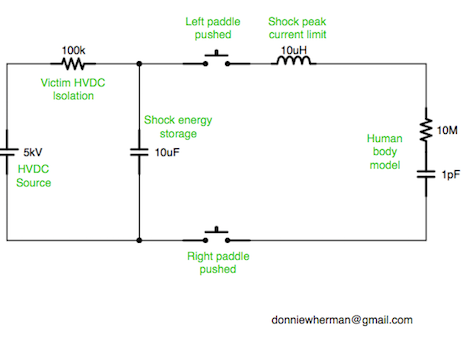Senior Project Weeks 7 & 8
- Ashwin West

- Apr 22, 2017
- 2 min read
Last week's objectives were to complete a working circuit outline and to begin construction of the tangible circuit. With the consultation of Donnie Herman, an expert in high voltage systems who has numerous experiences with AEDs, I was able to understand how the intricate components of the AED function.
Donnie's explanation started with the human body model. The human body has a high resistance and low capacitance when placed in series and varies depending on patient mass, thickness of skin, location of shock, etc. For the purposes of a demonstration, we will use a 300Ω resistor and led to demonstrate the shock is being applied (with the modified circuit). When applying a direct current to the model, there is no control over how much energy is actually applied. To mediate this, a pulse time-limit must be added to ensure that no matter how long the button is held, the current is released in a controllable form. The first step in creating the pulse is adding a resistor. Donnie recommended a value of 100KΩ because the corresponding current (using ohm's law) is about 50mA, which is controllable and non-lethal when applied to the body. For this project, we will be scaling down the individual values by a factor of 1/1000 to account for the output of the Arduino, which is around 5V (although we will purchase the actual 100KΩ resistor for consistency). The next step is to add the capacitor to provide the high voltage pulse required to shock. Since the energy is stored in the capacitor, it will determine the overall charge delivery to the victim. When the button to shock is pressed, the capacitor discharges, and instantaneous current is initially high but decays, making it non-lethal. The recommended value is 10μF because it cannot contain enough energy to harm a person. The final component of the circuit is something to limit the current applied by the capacitor, making the pulse time-limit. Donnie recommended an inductor because it softens the pulse current while still allowing for the transfer of energy, whereas a resistor would expel that energy as heat. A value of 10μH (micro-Henry) was recommended to complement the capacitor value.

This week's objectives are to assemble the circuit and test it to ensure proper connectivity to the Arduino system. My father and I will be going to a local electronics store to purchase the items in the circuit above. For the power source, we will use the Arduino to supply the current, and the paddles will be represented by switches. The goal of having a cellular-operated AED is having the Arduino interact with the switches to provide the shock when needed.
To conclude this week's session, I must give another thanks to Mr. Herman for not only walking me through the functionality of the AED, but also for helping me understand the values of the components. Without him, the project wouldn't have made the successful progress it has in the last two weeks.








Comments